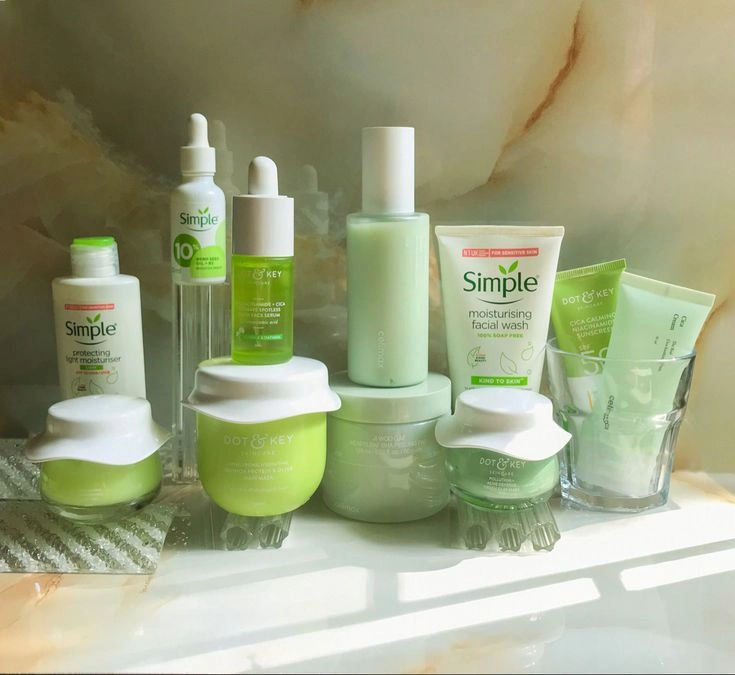Introduction
A vibrant skin complexion remains strongly connected to properly maintained healthy skin. Getting radiant skin does not need extensive procedures since persistence and appropriate products remain crucial elements. The following text presents a detailed explanation for a basic five-step skincare process which leads to glowing skin. This method includes cleansing and exfoliation together with toning alongside serum application followed by sunscreen application to produce a radiant and healthy appearance.
1. Cleanse: The Foundation of Healthy Skin
A skincare routine must begin with cleansing which serves as its essential starting element. Once applied your skincare products will work better to achieve their defined purposes. Your skin collects dirt together with excess oil makeup and pollutants and sweat throughout the day making pores get clogged and your complexion appears dull. Particular cleaning products extract unwanted materials from the skin without disrupting its original equilibrium.
The selection of cleanser requires you to consider your skin type among the different available options. People with oily skin should use products that are either gel-based or foaming cleansers to eliminate excessive oil on their skin. The best choice for dry skin is a cleanser based on oil or cream that provides hydration while soothing. Those who have sensitive skin should use a cleanser containing no scents which adds hydration without dryness effects.
Why cleansing is important:
Prevents clogged pores and breakouts.
The cleanser functions to eliminate skincare products alongside impurities found in the environment.
The correct use of this step makes the skin ready to receive skincare ingredients better than before.
How to cleanse:
Hot water should be avoided since washing your face with lukewarm water will prevent natural oil loss from the skin.
Put a minimal amount of cleanser onto your fingertips or cleansing brush then use circular motions for a period of 30 seconds to one minute.
2. Exfoliate: Reveal Fresh, Radiant Skin
Exfoliating is the process of removing dead skin cells from the surface of your skin. Over time, dead skin cells can accumulate, making your skin look dull and uneven. Exfoliating regularly can reveal brighter, smoother skin and improve the absorption of other skincare products.
There are two main types of exfoliants: physical and chemical. Physical exfoliants include scrubs and brushes, while chemical exfoliants use acids (such as AHAs or BHAs) to dissolve dead skin cells. For glowing skin, chemical exfoliants are generally recommended because they provide a more even and gentle exfoliation.
Physical exfoliation: Scrubs with small, gritty particles work by manually sloughing off dead skin cells. While effective, they can sometimes cause microtears in the skin if used too aggressively, especially on sensitive skin types.
Chemical exfoliation: AHAs (alpha-hydroxy acids) and BHAs (beta-hydroxy acids) are gentle exfoliants that dissolve dead skin cells without physical scrubbing. AHAs are water-soluble and work best for dry or sun-damaged skin, while BHAs, which are oil-soluble, are better for oily or acne-prone skin.
Why exfoliation is important:
- Removes dead skin cells, revealing a brighter complexion.
- Improves skin texture and reduces clogged pores.
- Enhances the effectiveness of other skincare products by allowing them to penetrate better.
How to exfoliate:
- Exfoliate 2 to 3 times per week to avoid irritation. Over-exfoliation can damage the skin’s protective barrier and lead to dryness or sensitivity.
- If using a physical scrub, apply it gently, without harsh pressure, and massage it in small circular motions.
- If using a chemical exfoliant, follow the instructions on the product. Many chemical exfoliants are leave-on products, meaning you apply them and let them absorb into the skin.
- Always follow up with a moisturizer after exfoliating to prevent skin dryness.
3. Tone: Balance and Hydrate
Toning is a step that many people skip, but it’s an essential part of any skincare routine, especially for glowing skin. A good toner can help balance the skin’s pH, remove any leftover impurities after cleansing, and prepare the skin for better absorption of treatments like serums and moisturizers.
Modern toners are much gentler than the astringents of the past, which were harsh and drying. Today’s toners are packed with hydrating and soothing ingredients like glycerin, rose water, or aloe vera. If you have oily skin, you can look for a toner with ingredients like witch hazel or salicylic acid, which help tighten pores and control oil.
Why toning is important:
- Restores the skin’s natural pH after cleansing.
- Hydrates and preps the skin for the next steps in the routine.
- Tightens pores and helps control oil production.
How to tone:
- After cleansing, apply toner to a cotton pad or directly into your hands.
- Gently press the toner into your skin, focusing on areas where you may have more oil or dryness.
- Allow the toner to absorb into the skin for about a minute before moving on to the next step.
4. Serum: Targeted Treatment for Radiance
Serums are highly concentrated treatments designed to address specific skincare concerns. They contain active ingredients that penetrate deep into the skin to target issues like dark spots, fine lines, and dehydration. For glowing skin, a brightening serum with ingredients like vitamin C, niacinamide, or hyaluronic acid can work wonders.
- Vitamin C is a potent antioxidant that helps brighten the skin and even out skin tone. It also protects against environmental damage and promotes collagen production, which can help maintain a youthful appearance.
- Niacinamide (vitamin B3) is known for its ability to reduce redness, calm irritation, and even out skin tone, making it ideal for people with pigmentation issues.
- Hyaluronic acid is a humectant that draws moisture into the skin, helping to keep the skin plump, hydrated, and radiant.
Why serums are important:
- Deliver concentrated, targeted treatment for skin concerns like dullness, fine lines, and dark spots.
- Provide hydration and nourishment deep within the skin layers.
- Enhance overall skin tone and texture, contributing to a glowing complexion.
How to apply serum:
- After toning, apply a few drops of serum to your face and neck.
- Gently massage it into the skin with your fingertips, using upward motions.
- Allow the serum to absorb completely before moving on to the next step.
5. Moisturize & Protect with Sunscreen: Seal in Hydration and Shield Your Skin
Moisturizing is essential for maintaining skin hydration and ensuring your skin stays soft and plump. Regardless of your skin type, using the right moisturizer will lock in moisture and help the skin stay hydrated throughout the day. If you have dry skin, opt for a richer cream or an oil-based moisturizer, while those with oily skin can use a lightweight, gel-based formula that won’t clog pores.
The most important aspect of this step is sunscreen. Protecting your skin from UV rays is crucial to maintain a glowing complexion and prevent premature aging. UV rays cause hyperpigmentation, wrinkles, and dullness. Always use a broad-spectrum sunscreen with SPF 30 or higher during the day, even on cloudy days.
Why moisturizing and sunscreen are important:
- Moisturizer keeps the skin hydrated, helping to prevent dryness and irritation.
- Sunscreen protects the skin from harmful UV rays, preventing sunburn, pigmentation, and premature aging.
- Sunscreen also helps maintain the effectiveness of other skincare products by shielding the skin from UV damage.
How to apply moisturizer & sunscreen:
- Apply a pea-sized amount of moisturizer to your face and neck, massaging it in gently.
- In the morning, finish your routine by applying a generous amount of sunscreen as the last step.
- Reapply sunscreen every 2 hours if you’re spending time outdoors.
Conclusion
Achieving glowing skin involves a combination of cleansing, exfoliating, toning, treating with serums, and moisturizing with sunscreen. Each step plays a vital role in keeping your skin healthy, radiant, and protected from environmental stressors. With consistency and the right products suited to your skin type, you’ll see improvements in your complexion, resulting in that coveted natural glow. Remember, glowing skin is a reflection of both good skincare habits and overall wellness, so hydrate, eat a balanced diet, and get plenty of rest for the best results.

